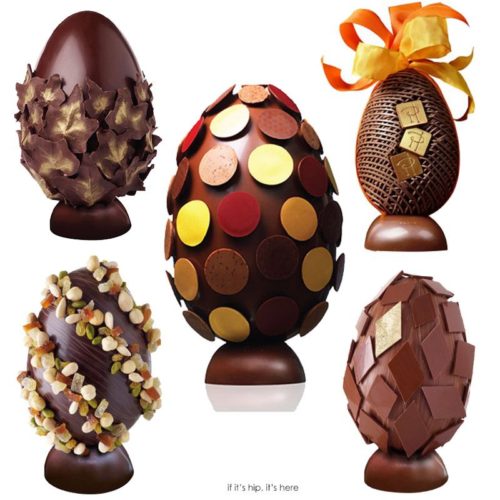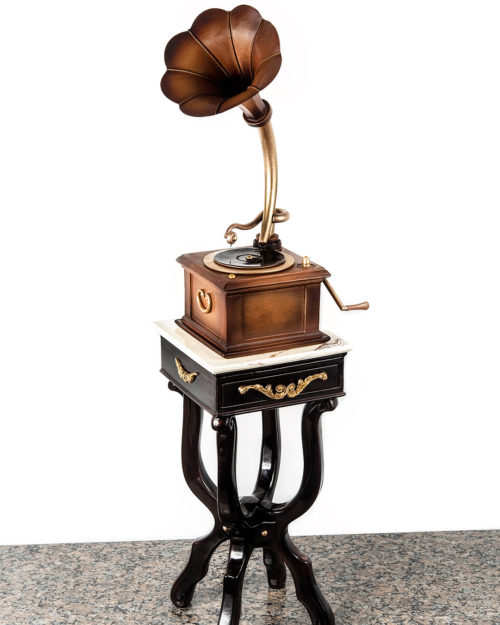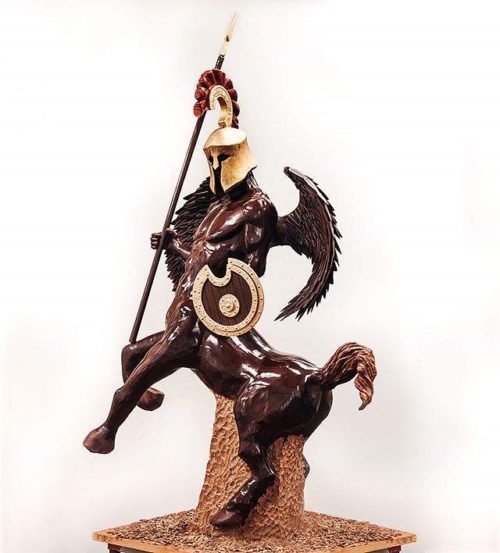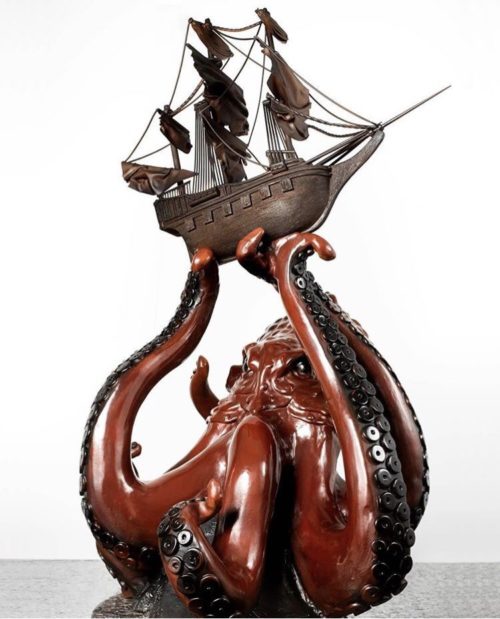While waiting to board between flights for Europe, I decided that instead of being glued to my computer and iphone like everyone else in the lounge I would revert to an earlier period in my life where reading a newspaper or magazine was all there was to pass the time. What a refreshing change that was.
I selected an English publication I had not heard of before ( by English I mean published in England ) that had written a fascinating article about a man named ‘Ivan Day’, an art historian by trade whose passion it was to examine cooking throughout the centuries. As I love to cook I read this article from beginning to end.
The article conjured images of roasting suckling pigs, fabulous meat pies, quince and pheasant pies, dinners by candlelight and roaring fireplaces. What could be more festive. Fascinating insights into how people celebrated the Holidays over the centuries.

Ivan Day photographed in front of his amazing creations.
The article written by Polly Russell ( Russell herself is a curator at the British Library), states that Ivan Day is a noted authoritarian on food making throughout the ages and runs food courses, advises museums and archives their collections and exhibitions. Day also has a website and has appeared on the BBC.
Day’s home is a charming authentic low beamed Medieval farmhouse in Cumbria that dates back to the 1600’s, replete with his collection of all the equipment needed to produce recipes as far back as the 1500’s. Day has a Medieval fireplace with a spit from the 1700.s that can roast a mutton, he also has antique copper moulds, both pie and jelly, fascinating implements for pie and pastry making that date back to the 1600’s.
Day’s passion began at the age of 13 when, after ducking into an antique store to escape the rain, he discovered a tattered old book published in 1723 by John Nott titled ‘The Cooks and Confectioners Dictionary’. He took one look, purchased the book as was hooked!

Ivan Day preparing a dish in his home surrounded by antique copper molds.
Since we’re well into the Holiday period, Ivan discusses the Christmas Feast and how it was enjoyed throughout the ages. In fact, I learned that Medieval people dined more lavishly than we do now. Feasts of 2 courses of 20 dishes each were prepared days in advance to insure a memorable experience at Christmas. It’s little wonder gout was such a problem back then.

Typical Tudor dress of the era.
Ivan Day explains that roast mutton was a staple at Christmas along with turkey, pheasant, swan, and other wild fowl (all served during the same seating). By the time Christmas came about these birds and animals were at their fattest and ready for butchering. As early at the 1500’s farmers were encouraged to grow Turkeys because they produced the most meat of any bird.
The Christmas pie was the centerpiece of the table. A chef named ‘Francatelli’ produced a pie in 1848 that consisted of truffles, turkey, pheasant and a small york ham that took two days to produce and 6 hours to cook. To produce a pie like this today, Ivan claims, would cost over $600!

A partridge pie created by Ivan himself. In the medieval period the chef would take the head and feathers of the actual bird so that people knew what they were eating.
Ivan also discusses the preparation that went into making desserts and sweets over the ages.

A ‘motto’ shortbread from the Victorian Era.
In a Christmas Day bill of fare by Robert May dated 1660 you can see below all the dishes that were prepared and served!
A BILL OF FARE FOR CHRISTMAS DAY AND HOW TO SET THE MEAT IN ORDER
by Robert May, 1660
Oysters
1. A collar of brawn [pork that is rolled, tied, and boiled in wine and seasonings].
2. Stewed Broth of Mutton marrow bones.
3. A grand Sallet [salad].
4. A pottage [thick stew] of caponets [young castrated roosters].
5. A breast of veal in stoffado [stuffed veal].
6. A boil’d partridge.
7. A chine (a cut of meat containing backbone) of beef, or surloin roast. Here’s May’s recipe:
To roast a Chine, Rib, Loin, Brisket, or Fillet of Beef
Draw them with parsley, rosemary, tyme, sweet marjoram, sage, winter savory, or lemon, or plain without any of them, fresh or salt, as you please; broach it, or spit it, roast it and baste it with butter; a good chine of beef will ask six hours roasting.
For the sauce take strait tops of rosemary, sage-leaves, picked parsley, tyme, and sweet marjoram; and strew them in wine vinegar, and the beef gravy; or otherways with gravy and juice of oranges and lemons. Sometimes for change in saucers of vinegar and pepper.
8. Minced pies.
9. A Jegote [sausage] of mutton with anchove sauce.
10. A made dish of sweet-bread (Here’s a recipe from A New Booke of Cookerie by John Murrell, published in 1615: Boyle, or roast your Sweet-bread, and put into it a fewe Parboyld Currens, a minst Date, the yolkes of two new laid Egs, a piece of a Manchet grated fine. Season it with a little Pepper, Salt, Nutmeg, and Sugar, wring in the iuyce of an Orenge, or Lemon, and put it betweene two sheetes of puft-paste, or any other good Paste: and eyther bake it, or frye it, whether you please.)
11. A swan roast.
12. A pasty of venison.
13. A kid with a pudding in his belly.
14. A steak pie.
15. A hanch of venison roasted.
16. A turkey roast and stuck with cloves.
17. A made dish of chickens in puff paste.
18. Two bran geese roasted, one larded [larding is inserting or weaving strips of fat in the meat, sometimes with a needle].
19. Two large capons, one larded.
20. A Custard.
THE SECOND COURSE FOR THE SAME MESS.
Oranges and Lemons
1. A young lamb or kid.
2. Two couple of rabbits, two larded.
3. A pig souc’t [sauced] with tongues.
4. Three ducks, one larded.
5. Three pheasants, 1 larded.
6. A Swan Pye [the showpiece: a pie with the dead swan’s head, neck, and wings sticking up from it].
7. Three brace of partridge, three larded.
8. Made dish in puff paste.
9. Bolonia sausages, and anchoves, mushrooms, and Cavieate, and pickled oysters in a dish.
10. Six teels, three larded.
11. A Gammon of Westphalia Bacon.
12. Ten plovers, five larded.
13. A quince pye, or warden pie [pears or quinces peeled and poached in syrup, then baked whole in a pie].
14. Six woodcocks, 3 larded.
15. A standing Tart in puff-paste, preserved fruits, Pippins, &c.
16. A dish of Larks.
17. Six dried neats [calf] tongues
18. Sturgeon.
19. Powdered [salted] Geese.
Jellies.
And you know, nothing says Christmas like powdered geese and jellies.
No where does it mention how many people were served at this feast. But we can assume it was more than 4!

Quince Tart or ‘Pastello de poma cotogne’ – or quince tart made from a recipe in Maestro Martino, Libro de arte coquinaria, perhaps the most important cookery text of the early renaissance. The hollowed out quinces are stuffed with bone marrow, sugar and cinnamon and baked on a puff paste base.
If your ambitious and think you’d like to try a Quince Tart or Pie, there are several modern day versions on the internet. You could try the original recipe dated in the 1660’s posted below: (if you can understand it…also the creation of the pastry is just assumed )
Quince Pye Recipe C.1660
Boil your Quinces in Water, sweetened with Sugar, till they be soft, then skin them and take out the Cores; after that boil the Water with a little more Sugar, Cloves, Cinnamon and Lemon peel till it becomes of the thickness of a Syrup; when cold lay your Quinces in Halves or Quarters, scattering Sugar between each Layer; put a pint of the Syrup, or more according to the Biggness of your Pye or Tart, make the Coffin round with close or cut Covers, and bake it pretty well. And thus you may do with Pippins and Pearmains, or with Winter-Fruit, and also with green Codlings.
If this article has you hungry for more, you can always fly to Cumbria and take one of Ivan’s 2 day courses at a cost of $600. Here’s an example of his course on Pie and Pastry Making

Pies created in the Pastry making course.
Pie Making and Pastry Course:
SATURDAY
10 am – Welcome and Introduction to the Course. This course is for those who want to improve the quality of their pastry and to learn to raise pies to a very high standard of workmanship. We will learn how to re-create English historical recipes from the seventeenth to the nineteenth century. Our sources will included recipes from Murrell, May, Kidder, Nott, Francatelli, Mrs Marshall and Gouffé.
10.45 – 13.00 – Hot water crust, freehand pie raising and wooden pie forms – we will make and decorate a number of raised pies from historical sources, including a Cheshire Pork Pie, a Stump Pie and some Marrow Chewitts.
13.00 – 14.00 – Lunch
14.00 – 17.00 – Lining Paste, Cold Water Paste and Metal Pie Forms – Using 19th century pie forms and boards for printing sprig decorations, we will make a very ambitious raised pie based on one of Agnes Marshall’s recipes.
17.00 – 20.00 – Free
20.00 – Historic dinner (lots of pies of course) at Wreay Farm
SUNDAY
10.00 – 13.00 A Lamb Pasty – we will make a highly decorative lamb pasty based on a design in Edward Kidder’s beautiful Book Receipts of Pastry and Cookery from the early eighteenth century.
13.00 – 14.00 – Lunch
14.00 – 17.00- Fine Pastry, Torts and Tarts – We will learn to make puff paste and paste royal and make some taffety tarts and a banniet tort.
As much as I love the sounds of all of this I am here in France. I’ve heard from friends that the very same thing exists here. I’ll see what I can find.
Until next time.
Thanks for reading.
Happy Holidays!
Mark LaFleur
The Antique Warehouse
226 SW Marine Drive
Vancouver, BC
Please visit our website at http://www.antiquewarehouse.ca























